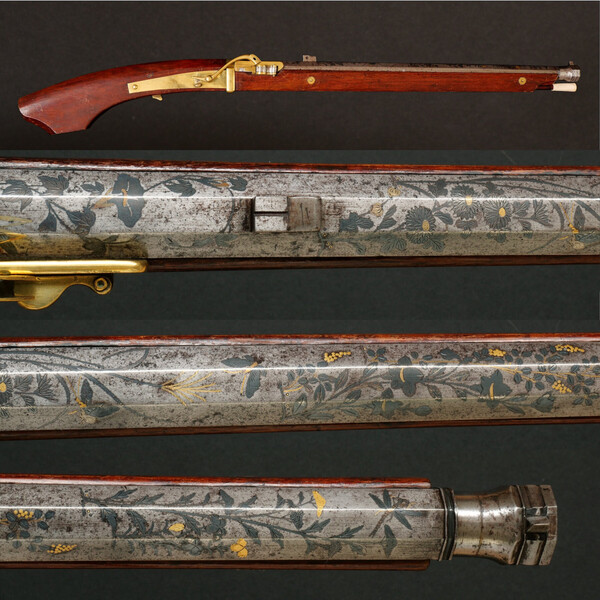All Activity
- Past hour
-

Old heirloom (?) tsuba translation request
Deez77 replied to Deez77's topic in Translation Assistance
Thank you Steve. Can you share your source for the stylistic writing examples? Damon -
It's the first pattern earlier aluminium tsuka, the screw position was moved after 11 months of production. We were discussing if it had been repainted, were thinking most probably not now. The metal fitting have definatelly been over cleaned.
-
When I look at the steel in this sword there is indeed a unique texture to it, it's like stars in the milky way reflecting back to you, so indeed, it must be a different kind of steel that we see in modern blades today. Some say koto steel is softer and can bend as opposed to shinto that will snap and break.
-
Curious that the screw slot has been hand punched. John C.
- Today
-
-
Early Type 94 Fujiwara Kanenaga Stainless
lonely panet replied to PNSSHOGUN's topic in Swords and Edged Weapons
i once hada a Kanenaga when first collecting 20 plus years ago, sold it cheap at a gunshow and have been kicking myself ever since, if its still around in a few weeks we will chat. great example -
Ryuminsai Kanetomo….unusual gendaito? Gunsuihaganane?
lonely panet replied to Matsunoki's topic in Military Swords of Japan
very saka choji -
It must be tricks of the lighting, because the color of the saya throat looks different than the rest of the saya. The wear patterns on the saya and belt ring look like wartime use. The color isn't as strange as the original photos made it seem. It's possible this is WWII paint.
-
Upcoming Nihonto Club Germany
kiku replied to BIG's topic in Sword Shows, Events, Community News and Legislation Issues
I think it would be important to say that NC Germany is a small local group of sword collectors. Guests shouldn't expect too much. -
Thank you @Dan tsuba, that's very helpful. I see what you see - but the "seam" on the leaf is very hard to see in person. After work I'll have to investigate that area more carefully, and I'll try to get a better clear photo of it. My thoughts about it? Mostly confused! haha. I see everything the CAST party says, but I also see everything the NOT-CAST party says. I simply don't know what to think... If it's cast - I will keep it as an example of a sneaky cast. If it's hand forged - even better! I'll also keep it . Ultimately, I have no plans to part with it, so I just want to know the truth. And hopefully learn something in the process, Cheers, -Sam
-
Hello Sam! Thanks for adding those pictures to the thread of your tsuba taken under the LED! I don’t know (and other opinions would be appreciated), but I think I see signs of casting. There appears to be a “casting seam” down the middle of one of the leaves (it was not fully filed down). There is also what appears to be a flaw on the bottom of one of the “swirls” attached to the hitsu-ana. Also, a “flaw” on the side of the seppa-dai that was probably something stuck somewhere in the mold? Anyway, I have included your picture with my interpretations of what I see circled. What are your thoughts about it? With respect, Dan
-
Book by NMB member steves87.. https://www.instagra...VvOP4zV/?img_index=1
-
Hello, I'm looking for information about this kind of teppo. It is a slim and short rifle/pistol with an overall lenght of 65 cm (barrel 41 cm, calibre 10,5 mm). It's most probably a Bajō-zutsu (or is there something equivalent to a wakizashi?). But what puzzles me the most is the unpatinated shiny barrel with these nice floral and insect inlays in gold and blackened silver, which i have never seen before. I'm not so familar with teppo and how they usually look like but I would expect a black-brownish barrel with silver inlays, so the barrel is protected and only the small silver parts may oxidize. But this way the whole iron barrel is prone to rusting, while silver and gold stay fine. Can someone confim, that this is the intended state or has pictures of similar examples? Or any hints, how these kind of teppo usually should look like?
-
I could understand justifying green papers for some blades that were papered in the old green-paper era and have been out of the country ever since. Maybe a blade being sold by someone without a deep knowledge that bought a sword many years ago and has had it in their collection ever since. However, any blade that is worth its salt, is worth getting repapered. Why? Because it will immediately add value to the sword. Dealers in Japan have much easier access to NBTHK shinsa than anyone else. So why would they not go through the small trouble of getting a blade papered if it would increase the value of the sword significantly? The only reason I can think of is that they are selling to the non-Japanese market where 99% of people would never have heard about green papers having issues in the past with attributions. I was this same person before I joined here. I saw plenty of blades with "official papers" and never thought to question until I read the article posted here regarding the older papers and their issues. It seems to me that the Japanese dealers know this, hardcore collectors know this, and Japanese collectors know this. The only ones who largely don't know this are novices and foreigners. Which seem to be the target audience of many of these eBay sellers based in Japan that are selling old-papered swords.
-
-
Help with understanding blade
DateMasamune replied to DateMasamune's topic in General Nihonto Related Discussion
Thank you, you have been most helpful. -
Thanks for clearing that up Brian, that makes sense. And apologies to David for the misunderstanding Thank you for that link Colin! And for the info and input Jeremy! I'll be reading over that thread while I procrastinate my work today Thanks again everyone, and sorry I let this thread jump all over the place. Cheers, -Sam
-
For those of you who have the fortitude to read it, this I think is the thread Jeremy refers to.
-
Beautiful stabilization/restoration work!
-
Dealers who have their own section are moderators over their own dealer area. David is moderator of Rain Dragon Antiques, even if the store is now not active, it still exists.
-
I have noticed this same thing and also thought there were other moderators albeit not as involved as @Brian.
-
Admittedly, I am very new to collecting TOSOGU but I am firmly in the forged camp of this OP TSUBA. What stands out to me is the inside surfaces. They appear to be very smooth and lack the pitting/texture, which I also feel could be purposeful texture if not produced by corrosion and subsequent stabilization and re-patination. I'm remembering another thread from around a year ago where @Ford Hallam had chimed in after I myself had thought a TSUBA was cast because of lack of detail and an overall pitted appearance. He stated that many surface textures were purposeful and pointed out other reasons for believing that particular TSUBA was forged in his opinion. It was a forum lesson I will not soon forget! Anyways, the point I'm trying to make is: wouldn't casting texture/pitting be uniform on all surfaces? The other thing that stands out to me are the crisp 90% angles of the edges. Most examples of cast TSUBA (of the iron-based variety) I have seen on the forum don't have these uniform and predominant sharp edges. What I get from the combination of these two things is that it was forged and chased/carved. Obviously, I could be wrong about these observations and I'm open to learn like most people on this great forum.

















